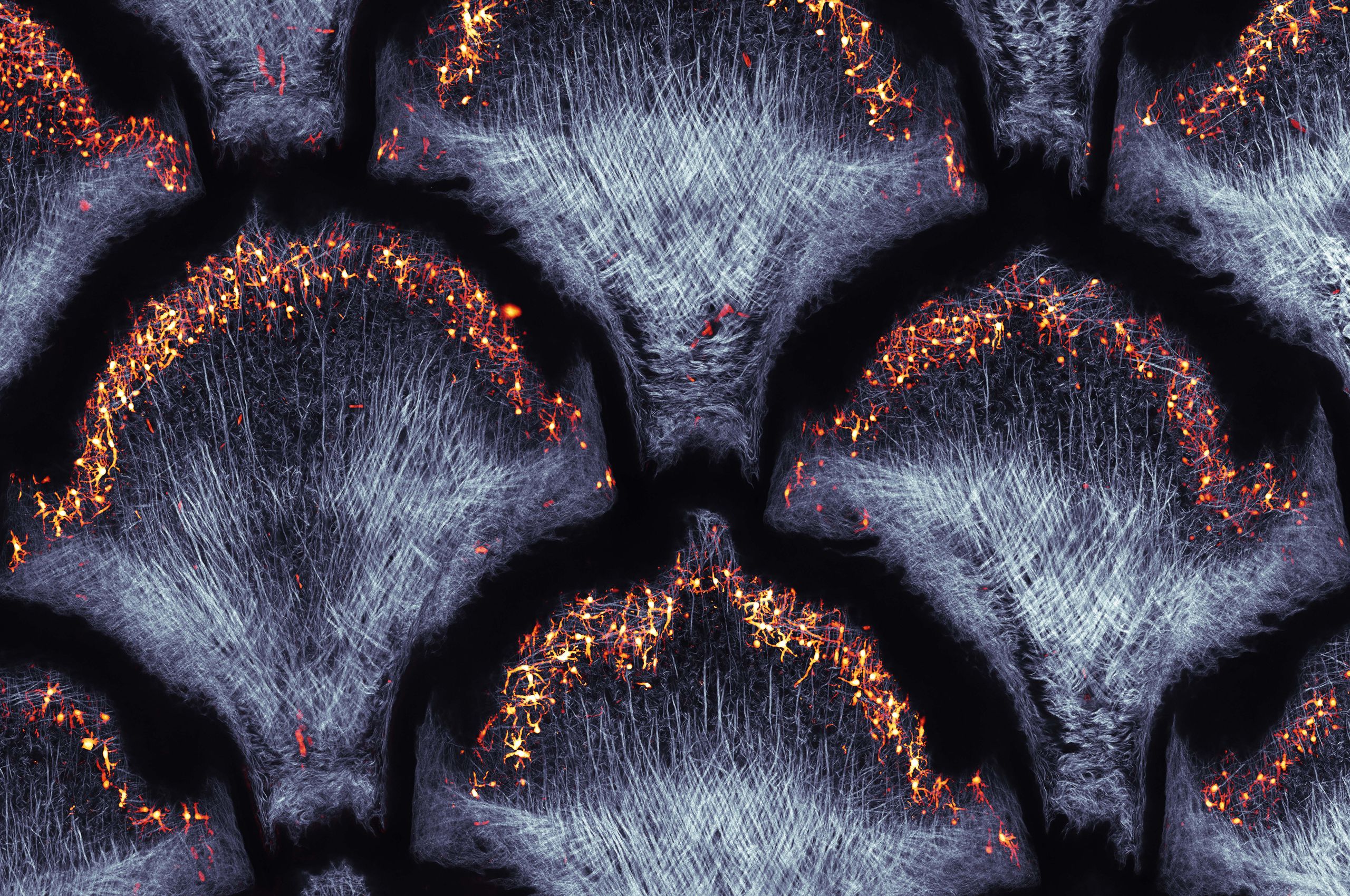Black holes, buckyballs and boxing hares — April’s best science images
The month’s sharpest science shots,
selected by Nature’s photo team.

Microscopic scales. This confocal-microscope image shows the scaly skin of an African house snake (Lamprophis spp.) embryo in exquisite detail. The bright dots along the edge of each scale show dermal pigment cells, and the silvery criss-crossing strands are collagen fibres. Grigorii Timin, a PhD student at the University of Geneva, Switzerland, captured the shot, which was a regional winner at the Olympus Image of the Year Award 2020.

Devastating losses. At a crematorium ground in New Delhi, funeral pyres cremate the bodies of those who have died from COVID-19. The pandemic is sweeping through India at a pace that has staggered scientists. Since late April, the government has reported more than 300,000 new cases each day. The unprecedented surge could be due to several factors, including the emergence of particularly infectious coronavirus variants, a rise in unrestricted social interactions and low vaccine coverage.

Credit: Alexander Ziegler
Emperor dumbo. Meet the emperor dumbo octopus Grimpoteuthis imperator, a rare species of deep-sea cephalopod described using non-destructive imaging techniques and DNA analysis. The specimen in these images was accidentally caught by geologists collecting rock samples from the depths of North Pacific Ocean.

Credit: Alexander Ziegler
When the research ship’s on-board biologist, Alexander Ziegler, saw the creature, he recognized it as a dumbo octopus — named because their large fins resemble an elephant’s ears — but suspected it was a species unknown to science. Further investigation confirmed this: magnetic resonance imaging and computerized-tomography scans allowed Ziegler to examine the octopus’s internal structure in detail while leaving its body intact — an approach he says could prove useful for characterizing rare specimens in future.

Credit: Alexander Ziegler
Credit: Alexander Ziegler

Credit: Alexander Ziegler
Credit: Alexander Ziegler
Credit: NASA’s Goddard Space Flight Center/Jeremy Schnittman and Brian P. Powell. (This video has no sound)
Credit: NASA’s Goddard Space Flight Center/Jeremy Schnittman and Brian P. Powell. (This video has no sound)
Binary black holes. This simulation shows how two supermassive black holes distort and redirect light emanating from their accretion disks — the maelstrom of hot gas that surrounds each one. To create the visualization, astrophysicist Jeremy Schnittman, at NASA’s Goddard Space Flight Center in Greenbelt, Maryland, used a supercomputer to calculate the path taken by light rays from the accretion disks as they made their way through the warped space-time around the black holes.

Credit: Erlend Haarberg/NPL
Credit: Erlend Haarberg/NPL
Furry fighters. For 25 years, wildlife photographer Erlend Haarberg has been capturing the hidden night life of mountain hares (Lepus timidus) in the forests of central Norway. During the mating season in April and May, rival males engage in boxing matches under the cover of darkness to fight for food or females. Haarberg says the first to land a direct hit on the head or body of his opponent is usually the winner.

Credit: W. Ejsmond et al./J. Archaeol. Sci.
Credit: W. Ejsmond et al./J. Archaeol. Sci.
Mummy and baby. Scans of an ancient Egyptian mummy, part of the collections at the National Museum in Warsaw since 1917, have revealed that it is the body of a pregnant woman — the first known example of an embalmed pregnant body. The identity of the woman and the cause of death remain a mystery. She was aged between 20 and 30 when she died around the first century BC, and researchers say that the way her body is carefully wrapped and adorned with mummy-shaped amulets (seen in right panel of the picture) suggest she had a high social status.

Plankton portrait. Photographer Angel Fitor says his project Sea Drops falls “somewhere between art and science”. Fitor used micropipettes to carefully place individual specimens of live plankton — tiny creatures measuring 200 to 1,500 micrometres across — inside specially lit drops of water to be photographed. The shots won third place in the Wildlife & Nature category of the 2021 Sony World Photography Awards. Following the photo shoot, the oblivious, unharmed plankton models were released back into the sea.

Credit: Richard Layfield
Credit: Richard Layfield
Old but not forgotten. Chemist Richard Layfield was shocked when a retiring colleague at the University of Sussex, UK, passed him the original samples of fullerenes — C60 and C70 — purified in the 1980s by the late chemist Harry Kroto. Kroto was at Sussex when he shared the 1996 Nobel Prize in Chemistry for the discovery of these cage-like carbon molecules, known as buckyballs. Layfield was also gifted the original instrument that analysed them, which still works.